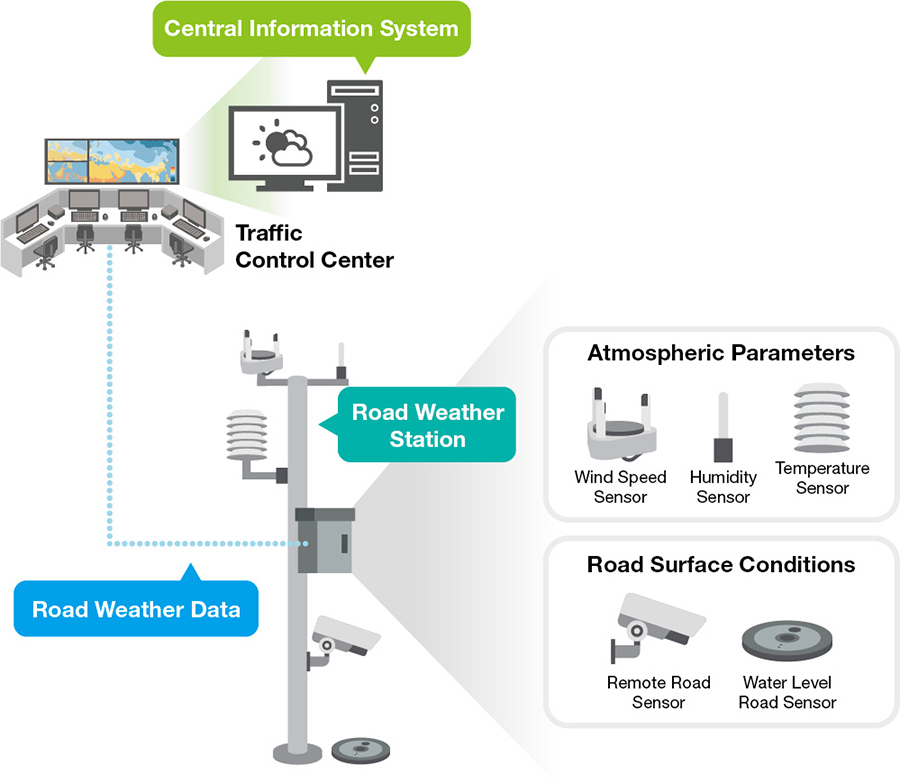Adverse weather conditions are the primary cause of traffic accidents in many parts of the world. In fact, 21% of all car crashes in the United States are weather related1. Providing instant alerts about constantly changing weather and road conditions—such as poor visibility due to heavy fog or dust storms, or icy roads that can cause cars to skid—enables motorists to take proper precautions and improve traffic safety for everyone.
Road Weather Information Systems (RWIS), which deploy advanced weather sensors and cellular technologies to collect real-time data on roadside conditions, are increasingly being adopted so that traffic operators can provide instant road and weather alerts to help motorists prevent accidents.
An RWIS usually consists of roadside weather stations connected to a central information system. Road weather stations collect real-time weather information, such as atmospheric parameters and road surface conditions, thanks to an array of sensors, such as air temperature sensors, pressure sensors, wind speed detectors, and road surface sensors. Road weather data is then transmitted via a communication network to a central information system located at a regional traffic control center.

The benefits include:
- Real-time information to help motorists plan the best route before starting their trip or adapt to changing conditions while driving;
- Traffic operators can respond more quickly to incidents; and
- Road maintenance workers can use current and historical RWIS data to prioritize requests and plan maintenance schedules.
Without a reliable means of data communication between the remote weather stations and the central system, however, information cannot be relayed to the control center and subsequently disseminated to motorists. Here are a few deployment tips to enhance connectivity for RWIS.
First, ensure your connectivity solution easily collects sensor data from multiple interfaces. Road weather stations employ a wide variety of field sensors to collect atmospheric parameters and road surface conditions. These sensors often use different communication interfaces, such as digital, analog, or serial, to collect I/O data. Connecting, maintaining, and replacing multiple sensors of different interfaces can be extremely daunting. So, besides supporting multiple interfaces, check if your connectivity solution provides easy-to-use hardware and software configuration for initial setup and future asset maintenance.
Second, back up your cellular network transmissions. While road weather stations and the central information system can be connected by a LAN network or optical fiber cables; oftentimes, it is not practical or cost-effective to do so. Communication over a cellular network fills the gaps. Nonetheless, to minimize unstable connections and ensure cellular network reliability, it is essential to have a backup mechanism for your cellular connection. For example, a dual-SIM card design can enable a cellular device to automatically switch to another carrier network when a base station fails to respond, or when the quality of the existing connection deteriorates to below an acceptable level. Aside from a backup mechanism supported by hardware design, your cellular devices should also have a software feature that can automatically detect connection issues and trigger a recovery process to resume cellular connections before these issues lead to a complete network failure. Choosing cellular devices with these features can enhance your communication reliability, reduce packet loss, and allow traffic operators to receive complete information for instant decision-making.
Third, use secure IT protocols to easily integrate your field data into the municipal network. As part of a citywide network infrastructure, the traffic control center needs to communicate with other systems using IT protocols. As most field sensors only support OT protocols, connectivity solutions that support both OT and IT protocols allow easier integration into the IT-based RWIS. It also saves time and effort spent on converting different data formats. Secure IT protocols, such as SNMPv3, can also reduce the risk of data exposure when transmitting information over cellular networks and unsecured public connections.
As a leading expert in industrial networking, Moxa has helped transportation authorities around the world improve road safety through reliable connectivity solutions that keep their RWIS up and running. Download our case studies and see how other companies developed customized communication systems with Moxa for their weather-monitoring applications.
Do you need help selecting connectivity or networking products for your project? Download our E-book and learn about the key criteria for choosing the right products for your requirements.
1 Source: https://ops.fhwa.dot.gov/weather/q1_roadimpact.htm